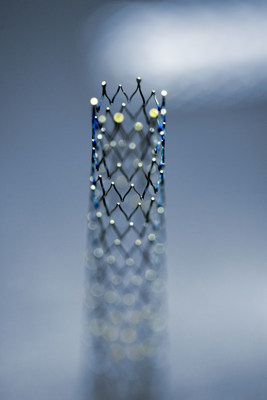BIOTRONIK US Announces Pivotal Trial Results Of The Pulsar-18 Stent With 4-French Delivery System
LAKE OSWEGO, Ore., July 3, 2017 /PRNewswire/ -- BIOTRONIK today announced the results of the BIOFLEX-I clinical study and availability of Pulsar®-18 for the treatment of patients with peripheral artery disease (PAD).

Pulsar-18 is the only superficial femoral artery (SFA) self-expanding stent approved by the FDA with a 4-French (4F) delivery system, enabling simpler, safer and more efficient procedures than larger diameter delivery systems. Procedure times are reduced because the 4F system more easily crosses lesions,[1] lowers access site complication rates and requires less compression time without the need for a closure device.[2]
Twelve-month data from the BIOFLEX-I study demonstrates the safety and efficacy of the self-expanding stent for blocked SFAs, the main arteries in the lower limb. In lesion lengths up to 190 mm, clinical findings demonstrated:
- 99.7 percent freedom from major adverse events (MAEs)[3] at 30 days
- 87.6 percent freedom from clinically-driven target lesion revascularization (TLR) at 12 months
- 66.8 percent primary patency[4] at 12 months
The study results were presented during a late-breaking session at the 2017 Complex Cardiovascular Catheter Therapeutics Advanced Endovascular and Coronary Intervention Global Summit (C3).
"SFA blockages are often challenging to navigate and treat because of the length of the artery and frequent presence of diffuse disease. Reduced blood flow to the limb can lead to amputation, so it is critical that patients are treated quickly and effectively," said BIOFLEX-I US Principal Investigator Mark Burket, MD, FACC, FSCAI. "Because of Pulsar-18's flexibility, small delivery system and thin struts, the stenting procedure takes less time, reduces complications and allows for earlier patient discharge."
With low Chronic Outward Force and thin struts (140 m)[5], Pulsar-18 may reduce vessel injury and inflammation,[6] provide faster endothelialization[7] and lower the risk of restenosis.[8] The BIOFLEX-I study found improved clinical and quality of life metrics, including ankle-brachial index (ABI), six-minute walk and walking impairment questionnaire (WIQ).
"More than 8.5 million people in the United States have peripheral artery disease. This patient population deserves innovative treatment options that help them return to their normal activity as quickly as possible," said Marlou Janssen, President of BIOTRONIK, Inc. "BIOFLEX-I clinical data confirms Pulsar-18 provides physicians with an effective solution that reduces procedure time and improves outcomes."
Pulsar-18 received FDA approval on March 23, 2017 and is available in the United States though BIOTRONIK's distribution partner Getinge.
Clinical follow-up for the prospective, international, multicenter, two-arm investigational device exemption (IDE) trial will total 36 months. More information on the BIOFLEX-I study is available at www.clinicaltrials.gov (identifiers NCT01319812, NCT01661231).
About BIOTRONIK
A global leader in cardio- and endovascular medical technology, BIOTRONIK is headquartered in Berlin, Germany, and represented in over 100 countries. Several million patients have received BIOTRONIK implants designed to save and improve the quality of their lives, or have been treated with BIOTRONIK coronary and peripheral vascular intervention products. Since its development of the first German pacemaker in 1963, BIOTRONIK has engineered many innovations, including Magmaris®*, the first clinically-proven resorbable magnesium scaffold; BIOTRONIK Home Monitoring®; Pulsar®-18, the world's first 4F compatible stent for treating long lesions; Orsiro®**, the ultrathin 60 micron drug-eluting stent; and the world's first implantable cardioverter defibrillators and heart failure therapy devices with ProMRI® technology.
* Not currently available in the United States.
** CAUTION Investigational device. Limited by United States law to investigational use.
For more information, visit: www.biotronik.com
Twitter: @BIOTRONIK_US
Facebook: facebook.com/BIOTRONIKUS
LinkedIn: linkedin.com/company/BIOTRONIK
YouTube: youtube.com/channel/UC3d_gUXhUICD-mxHRYDoHcQ
[1] 6.0 mm diameters. BIOTRONIK data on file.
[2] Bosiers, Marc MD, et al. 4-FrenchCompatible Endovascular Material Is Safe and Effective in the Treatment of Femoropopliteal Occlusive Disease: Results of the 4-EVER Trial ENDOVASC THER 2013;20:746756
[3] Major adverse events defined as a composite of procedure or stent-related death, target lesion revascularization, or target limb amputation.
[4] Primary patency defined as a PSVR <2.4 on duplex ultrasound and confirmed by the Core Laboratory.
[5] Strut thickness for 6.0 mm diameters. Leading competitors have been selected based on the USA PV SFA Self-Expanding Stent Revenue Market Share, 2016; (Source: Millennium Research Group, Inc.). Latest FDA approved SFA self-expanding stents for each manufacturer. Supera stent not possible to test due to its design and applied test method. BIOTRONIK data on file.
[6] As demonstrated in pre-clinical studies: Zhao HQ, Nikanorov A, Virmani R, Jones R, Schwartz LB. Late stent expansion and neointimal proliferation of oversized nitinol stents in peripheral arteries. Cardiovasc Intervent Radiol. 2009 Jul; 32(4); 720-6.
[7] As demonstrated in pre-clinical studies: Konstantinos C. Role of Endothelial Shear Stress in Stent Restenosis and Thrombosis. JACC 2012.; Koppara et al. Circ Cardiovasc Interv 2015; 8: e002427; EuroIntervention. 2010 Nov;6(5):630-7. Soucy N, Feygin J et al.
[8] As demonstrated in pre-clinical studies: Freeman JW, Snowhill PB, Nosher JL. A link between stent radial forces and vascular wall remodeling: the discovery of an optimal stent radial force for minimal vessel restenosis. Connect Tissue Res. 2010 Aug; 51(4): 314-26; Ballyk PD. Intramural stress increases exponentially with stent diameter: a stress threshold for neointimal hyperplasia. J Vasc Interv Radiol. 2006 Jul;17(7):1139-45; Zhao HQ, Nikanorov A, Virmani R, Jones R, Pacheco E, Schwartz LB. Late stent expansion and neointimal proliferation of oversized nitinol stents in peripheral arteries. Cardiovasc Intervent Radiol. 2009 Jul; 32(4): 720-6.

To view the original version on PR Newswire, visit:http://www.prnewswire.com/news-releases/biotronik-us-announces-pivotal-trial-results-of-the-pulsar-18-stent-with-4-french-delivery-system-300482985.html
SOURCE BIOTRONIK

